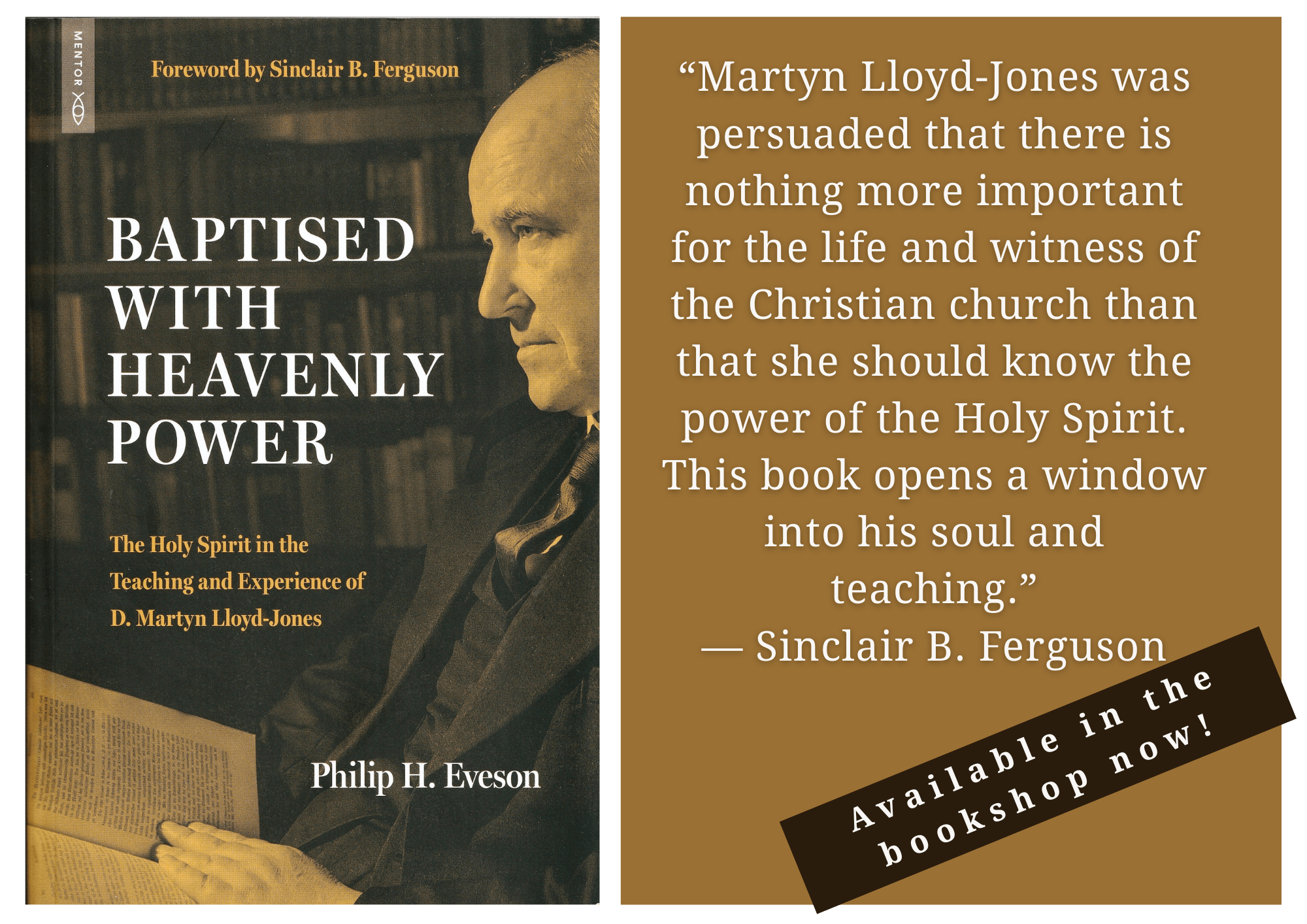Philip Eveson has written an important and accessible account of what has been called the most controversial aspect of Dr Lloyd-Jones’ teaching. I was aware of some of the criticism that had been made of him, but was shocked by both their volume and venom. The author is able to show convincingly that his subject’s teaching is far from unique and is vital for the health and vitality of the church. Mr Eveson’s approach is measured in providing both a theological and a historical context. His method is indeed Lloyd-Jonesian!
Part One: Theological Background
Chapter 1 demonstrates conclusively the Doctor’s credentials as an unashamed Calvinist. Chapter 2 on Calvinistic Methodism shows how deeply he was influenced by the eighteenth-century revival leaders in Wales such as Harris and Rowlands, Whitefield in England, and Edwards in the USA. Here was experiential Calvinism rather than formal confessionalism. Chapter 3 on Puritanism may seem misplaced, being of the previous century. But the author is following the great man’s path of discovery. He was first introduced to the treasure trove of pastoral insights from comments made by Methodist leaders. Chapter 4 on the Importance of Theology flows naturally from the lessons learned from earlier chapters. With this background the Doctor was able to avoid extremes: ‘a tendency to fanaticism and excesses or a tendency toward barren intellectualism, and a mechanical and dead kind of orthodoxy’.
Part Two: Theology of the Holy Spirit
Chapter 5 is entitled ‘The Person and Work of the Holy Spirit’. Once again the author provides the big picture by describing the ‘ordinary’ work of the Holy Spirit. The Doctor came to see that Pentecost was not pre-eminently the founding of the Christian Church but a new epoch in the history of redemption. Chapter 6 is brief and deals with the ordinance of baptism and the new birth. The chapter on the Baptism of the Holy Spirit then follows. It is what Jesus does. It is associated with spiritual revival in the life of an individual believer and more generally in the life of the church. He was adamant that it meant more than regeneration. Chapter 8 is entitled Post-Pentecost Experiences and charts the advent of the Charismatic Movement and the differing approaches of Dr Lloyd-Jones and John Stott. Chapter 9 is entitled Assurance and the Doctor said the supreme purpose of the Baptism of the Spirit is to give us certainty that we are the children of God. Sealing and earnest are important terms in this context. Chapter 10 on Pentecost and Spirit Baptism shows that Dr Lloyd-Jones teaching is soundly grounded in Scripture and points to the profound need of the Spirit’s power for the church to effectively witness to an unbelieving world. Chapter 11 is entitled Baptisms, Fillings, and Sealings. He declared that Pentecost was unique but the Book of Acts and church history record further outpourings. Chapter 12 on Evidences and Effects of Spirit Baptism.
The Doctor was cautious but open regarding the Gifts of the Spirit, putting him at odds with Charismatics. For him, the main effect was a baptism of power.
Part Three: Revival and the Holy Spirit
Chapter 13 is entitled ‘Theology of Revival’. This reader was shocked that some books on the Holy Spirit omitted any mention of revival. Dr Lloyd-Jones’ interest was primarily in the advancement of Christ’s Kingdom and the honour of God’s holy name. He distinguished it from renewal which he saw as yielding to what you already had at regeneration. Revival by contrast is something done to us – an outpouring of the Spirit. He based his theology on Old Testament texts as well as from the New Testament. Chapter 14 has the provocative title: ‘Revival – an Obsessional Trait?’ Philip Eveson absolves him of any unhealthy obsession with revival. He shows the breadth and depth of the Doctor’s ministry. However, Dr Lloyd-Jones was profoundly influenced by the writings of Jonathan Edwards, the history of the Welsh Calvinistic Methodists and his own spiritual experiences.
Part Four: Preaching and the Holy Spirit
Chapter 15 is ‘Theology of Preaching’. Dr Lloyd-Jones said:
Preaching is theology coming through a man who is on fire.
He stressed the study of biblical theology with systematic theology acting like scaffolding. Preaching for him had primacy for the upbuilding and establishing of the saints and the evangelisation of those who are not believers. The Doctor practised expository preaching. A sermon without application was a lecture. Preaching should always be under the power of the Spirit. True preaching was ‘God acting’. He stressed the need for the preacher to be ‘called’. He believed were ‘born not made’.
Chapter 16 is ‘Types of Sermon’. He preached experiential messages, mainly directed at believers, to inform, encourage, and promote growth. His preaching of instructional messages tended to be at mid-week meetings.
He gave messages at special events, such as the death of George VI and the anniversary of the Aberfan Disaster. He is particularly remembered for his evangelistic messages. Mrs Lloyd-Jones once said:
No-one will ever understand my husband until they realise that he is first a man of prayer and then, an evangelist.
In almost all his messages he mentioned the Holy Spirit and His power. Chapter 17 is headed ‘The Uniqueness of Preaching’. Dr Lloyd-Jones had his own distinctive style of preaching. His rigorous medical training was used to good effect in his detailed exegesis. However, he realised that humankind’s chief problem was sin – our wrong relationship with God.
Chapter 18 is entitled ‘Experiences of God’. The Doctor’s preaching was gripping and powerful. He used penetrating logic to destroy false arguments en route to declaring the truth as it is in Jesus. He emphasised the necessity of new birth as a result of the Spirit’s secret work. Profound spiritual experiences in 1949 convinced him that sound doctrine was not enough, the truth must affect the conscience and the emotions. There was a need to experience divine love and to have fellowship with God.
Chapter 19 is on ‘Loyalty to God’s Word’. Dr Lloyd-Jones’ preaching was authoritative because he was convinced concerning the trustworthiness of the whole canon of Scripture. He systematically read through the whole Bible each year. He was a convinced Creationist, believed in penal substitutionary atonement, and eternal judgement. Eveson writes:
The Spirit of God used this man’s faithfulness to the Scriptures and appreciation of them to powerful effect.
Chapter 20 is entitled ‘Word and Spirit’. In a sermon on 1 Thessalonians 1:5 he said:
Let us go on preaching the truth, but let us at the same time pray unto God to open the window of heaven and to baptise us anew and afresh with the power of the Holy Ghost.
He called preaching with an unction ‘prophetic preaching’. He emphasised that the Holy Spirit blesses careful preparation and must never be thought of as an alternative. He urged prayer for both the preacher and the congregation.
Chapter 21 is headed ‘Conclusions’. Mr Eveson notes that the Doctor’s concern was pastoral. He did not set out to write systematic or biblical theology. Many of his statements were in the context of a sermon and could be subject to some exaggeration in driving home a point. His approach built on a rich heritage and was based on careful biblical analysis. He was pietistic in that he sought spiritual life and power but he was in no way ‘escapist’. He eschewed mysticism, which usually by-passed Christ. But he was experiential.
Although he highlighted a missing note in Reformed teaching, he was no Charismatic. He opposed the Pentecostal insistence that tongues were proof of the Baptism of the Spirit. The accusation that he was not Reformed is shown to be absurd. He believed in right doctrine but he was not a cessationist, being cautious but open on the Gifts of the Spirit.
I apologise for the length of the review. I trust you will see the importance of this book in correcting some incorrect thinking about Martyn Lloyd-Jones. He is a sure and reliable guide. His emphasis is just as important today as when he was alive.
Kerry Orchard
There are two Appendices which are well-worth reading. The first is entitled Evan Roberts and the 1904 Revival and the second is a valuable fragment of MLJ’s 1930-31 spiritual journal.
Editor: There are two Appendices which are well-
wroth reading. The first is entitled Evan Roberts and
the 1904 Revival and the second is a valuable
fragment of MLJ’s 1930-31 spiritual journal.



